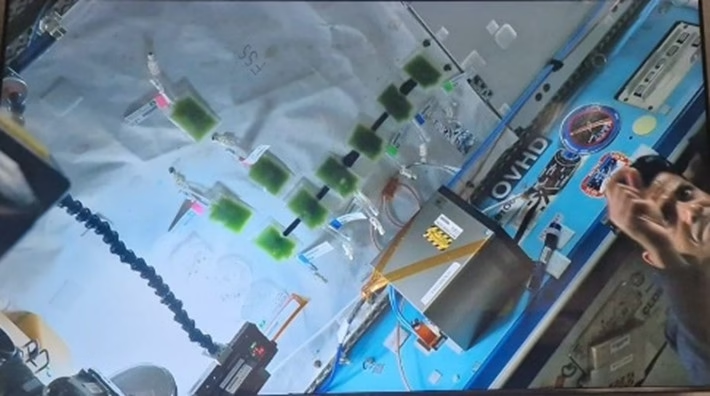Discover how ISRO microgravity experiments aboard the ISS (International Space Station) are shaping the future of space biology, sustainability, and robotics.

ISRO’s microgravity experiments on ISS include studies on tardigrades, muscle growth, and algae sustainability.
ISRO Microgravity Experiments Aboard the ISS: Advancing India’s Role in Space Science
The Indian Space Research Organisation (ISRO) has taken a significant leap in space biology and microgravity research by conducting a series of scientific experiments aboard the International Space Station (ISS). These experiments, facilitated under the Axiom Mission 4 (Ax-4) and supported by international collaboration, are part of ISRO’s strategy to develop technologies and scientific understanding crucial for long-term human spaceflight and deep-space exploration.
At the core of these ongoing efforts are multiple pioneering ISRO microgravity experiments focusing on life sciences, sustainability, and human-machine integration. From investigating the behavior of resilient microorganisms like tardigrades to studying algae’s oxygen-producing potential in orbit, ISRO is exploring the boundaries of what is possible in space-based science.
This article provides a detailed overview of these experiments, their objectives, progress, and the broader implications for India’s growing ambitions in space.
Overview of ISRO Microgravity Experiments
Microgravity research allows scientists to study biological and physical processes in ways that are impossible on Earth. By removing the variable of gravity, researchers can isolate other forces and examine how systems function in the space environment. ISRO microgravity experiments are particularly aimed at:
- Understanding biological responses to space conditions
- Enhancing sustainability through life-support research
- Improving astronaut health during extended space missions
- Advancing robotics and human-machine interfaces in orbit
These goals align with India’s future plans, including the Gaganyaan human spaceflight program and long-term lunar or planetary missions.
Tardigrade Resilience Study: Completed Successfully
One of the first ISRO microgravity experiments to reach completion involved the study of tardigrades—microscopic, water-dwelling animals known for their ability to survive extreme conditions.
Purpose of the Experiment
Tardigrades are extremophiles, meaning they can survive high radiation, freezing temperatures, dehydration, and even exposure to the vacuum of space. ISRO researchers sought to understand the molecular and genetic mechanisms behind this resilience in microgravity conditions.
The goals included:
- Observing changes in gene expression and protein synthesis under spaceflight conditions
- Identifying stress-response mechanisms that help organisms withstand space exposure
- Evaluating their suitability as biological models for future space biology research
Results and Implications
The experiment was concluded successfully. Post-mission analysis will focus on genomic, proteomic, and transcriptomic changes in the organisms. These findings may support the development of robust biological systems capable of surviving long-duration spaceflight or enhancing bioengineering approaches for future space missions.
ISRO Microgravity Experiments Aboard the ISS: how muscle cells form and develop in a microgravity environment.
Objectives
This experiment examines:
- The differentiation of muscle progenitor cells into muscle fibers
- Changes in cellular signaling pathways associated with growth and regeneration
- The effect of space stressors on muscle cell health and structure
Understanding muscle degeneration in microgravity not only helps in developing countermeasures for astronauts but also offers insights into treating muscular disorders on Earth.
Current Status
The myogenesis study is currently underway aboard the ISS, with periodic monitoring of cell cultures. Samples will be returned for lab analysis once the experiment concludes. This study represents a step toward improving astronaut physical health during extended space journeys.
Microalgae and Cyanobacteria Study: Life-Support Systems of the Future
Another critical ISRO microgravity experiment focuses on cultivating microalgae and cyanobacteria in space. These microorganisms have potential applications in sustainable life-support systems for long-term missions.
Rationale
Microalgae are capable of photosynthesis, converting carbon dioxide into oxygen, and producing biomass that can serve as food or waste-processing agents. The ability to grow and adapt to space conditions is key to creating closed-loop ecosystems in future space habitats.
Research Objectives
- Monitor the growth rate and oxygen production capacity in microgravity
- Evaluate structural and genetic changes in the organisms due to space exposure
- Test their resilience to cosmic radiation and limited nutrients
Progress and Potential
This experiment is ongoing aboard the ISS. Initial indicators suggest positive adaptation, though full analysis will depend on the recovery and study of the biological samples. Successful algae cultivation in orbit could lead to scalable bio-regenerative systems supporting human life in space.
Human-Machine Interface (HMI) Testing: Toward Smarter Space Robotics
With automation playing an increasingly important role in space missions, ISRO is also conducting an experiment focused on human-machine interaction in microgravity environments.
Experiment Design
The Human-Machine Interface (HMI) experiment evaluates:
- How astronauts interact with robotic systems under zero gravity
- Response accuracy and timing in voice and gesture-based commands
- The cognitive load involved in real-time operations with smart systems
This research has direct applications in enhancing robotic assistance aboard spacecraft, during extravehicular activities, and even for planetary surface missions. By improving HMI systems, ISRO aims to reduce astronaut workload and increase mission efficiency.
Ongoing Monitoring
The HMI experiment is currently active on the ISS, with real-time interaction logs being collected. Data collected will support the development of AI-driven robotic companions for future missions under the Gaganyaan program and beyond.
Scientific and Strategic Impact of ISRO Microgravity Experiments
These experiments reflect a multi-disciplinary approach to space research, combining biology, robotics, and environmental science to solve real-world problems in space exploration.
Strategic Value for India
- Enhancing Space Biology Capabilities
India gains valuable expertise in life sciences, a field traditionally dominated by established space agencies like NASA and ESA. - Preparation for Human Spaceflight
Data from these studies will be integrated into astronaut training, habitat design, and health protocols for India’s Gaganyaan and future interplanetary missions. - International Collaboration
These experiments strengthen India’s ties with global space entities, including NASA and Axiom Space, opening doors for future joint missions and shared research facilities. - Terrestrial Benefits
Findings from space-based research often lead to technological and medical advancements on Earth, including new treatments, sustainable agriculture, and AI innovations.
Data Collection and Post-Flight Processing
All ISRO microgravity experiments include robust data collection protocols. Once returned to Earth, the biological and machine interface samples will undergo thorough analysis at ISRO labs and partner academic institutions.
Techniques Involved
- Genomic sequencing (DNA/RNA analysis)
- Proteomic and metabolomic profiling
- Optical and electron microscopy
- AI-based behavior analysis (for HMI)
This post-mission phase is essential for validating hypotheses and developing applicable models for future use.
Japan’s H2A Rocket Retired After Successful Final Launch: A Legacy of Precision and Reliability Ends
India’s Future in Microgravity Research
ISRO is already planning the next wave of microgravity experiments, including 3D bioprinting, space farming, and advanced AI systems. These efforts will continue aboard international missions and eventually on Indian space stations or lunar orbiters.
The long-term goal is to make India self-reliant in space exploration, equipped with the tools and knowledge to support human life far from Earth.
Conclusion: ISRO microgravity experiments aboard the ISS
ISRO microgravity experiments aboard the International Space Station represent a significant milestone in India’s space research journey. By addressing key challenges in biology, sustainability, and robotics, these experiments position ISRO as a serious contender in the global space science arena.
As the world looks toward Mars, the Moon, and beyond, India’s investments in space-based science and technology are not only timely but essential. The insights gained from these experiments will shape the design of future space missions, improve astronaut well-being, and provide Earth-based benefits that impact society at large.
Through innovation, collaboration, and scientific rigor, ISRO continues to make its mark as one of the leading contributors to the future of human space exploration.
News Source:-
https://x.com/ISROSpaceflight/status/1941180952023384432?t=xXMp-WkD0clbgQ3hBhfTtw&s=19
FAQs: ISRO microgravity experiments aboard the ISS
Q1: What is the objective of ISRO microgravity experiments?
The primary goal is to study biological and mechanical systems in a gravity-free environment to improve sustainability, astronaut health, and robotic systems for future space missions.
Q2: Why study tardigrades in space?
Tardigrades are known for their survival abilities under extreme conditions. Studying them in space helps identify genetic mechanisms that could support long-term space life systems.
Q3: What is the significance of studying microalgae in orbit?
Microalgae can produce oxygen and process waste, making them ideal for closed-loop life-support systems on future space stations or planetary colonies.
Q4: How does the HMI experiment benefit astronauts?
It enhances the interaction between humans and machines in space, allowing astronauts to control robots more efficiently and safely in zero-gravity environments.
Q5: How do these experiments help India’s space program?
They support the development of human spaceflight capabilities, increase scientific knowledge, and promote global collaboration, ultimately strengthening India’s space infrastructure.
Axiom Mission 4 Crew Successfully Arrives at the ISS: Shubhanshu Shukla and Team Begin Their Historic Journey
